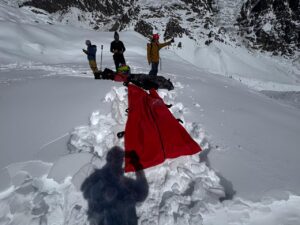The Ama Dablam season is at full throttle. Rope-fixing work culminated on Thursday and summits started right away; almost immediately, the mountain saw its first rescue of the season.
Earlier today, a helicopter used a longline to rescue Brian Harring Boll, a 53-year-old climber from Denmark, the Himalayan Times reported. Boll showed signs of AMS and snow blindness after reaching the summit yesterday, according to outfitter Friends Adventure. Boll couldn’t reach camp on his own and called for help from on the Mushroom Ridge, between Camp 2 and Camp 3. The helicopter picked him up from Camp 2.
You can view a video, shot on the ridge by Lakpa Dendi Sherpa, below.
Long-line operations involve a helicopter dropping a rescuer with a cable to secure an injured climber. Both people are then airlifted, hanging from the cable, down to Base Camp. These rescues have become somewhat of a common sight on Ama Dablam during peak season. Long-line rescues are safer, both for the victim and for the rescuers, than a ground rescue.
The operation, carried out by Kailash Helicopter Services, was successful and Boll is already at a hospital in Kathmandu.
Easier, but not by much
Ama Dablam is one of the most popular climbing peaks in Nepal. It is stunning, easy to access in the Khumbu Valley, and has the prestigious “serious climb” aura, even on its normal route.
But rope-fixing protocols have reduced the climb’s difficulty. Ama Dablam is one of four peaks in Nepal (alongside Everest, Lhotse, and Manaslu) on which Nepal’s Expedition Operators Association assigns rope-fixing work in advance. This results in a team that is specifically assigned to fix the ropes and keep the entire route properly equipped, paving the way for many climbers during the season.
Yet, Ama Dablam still provides a sustained steep climb, with sections on rock, some mixed terrain, and a final section on snow.
Also noteworthy is that the mountain is typically climbed without supplementary O2, which requires greater endurance and proper acclimatization. “Many climbers go to a trekking peak such as Island Peak or Lobuche before Ama Dablam, so they get to the mountain already acclimatized,” Dawa Steven of Asian Trekking told ExplorersWeb.

Basque climbers on Ama Dablam’s Mushroom Ridge in 2006. Photo: Summit Post
Fall hot spot
You can climb Ama Dablam in both spring and autumn. In fact, it can be tackled through December and even into winter, thanks to slightly milder conditions than other major peaks, and easy-to-arrange logistics (either with a tented Base Camp or using lodges in the area).
However, the mountain’s peak season is October because of the availability of commercial outfitters.
“In spring, outfitters are mainly focused on Everest and other 8,000’ers, where they assign most of their resources,” Dawa Steven explained.
September is usually devoted to Manaslu and, this year, the Tibetan peaks. Most sherpas and their clients arrive at Ama Dablam’s Base Camp after the first week of October.






